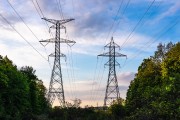The Government of the Northwest Territories (GNWT) released their 2022 to 2025 Energy Action Plan earlier this month. Despite the 68 actions and $194 million allocated towards clean energy initiatives, compared to the 44 actions and $138 million spent in the previous four years, the plan still only amounts to incremental progress.
These are positive investments, but the GNWT needs to invest more to get on track to reach their emissions reduction target of 517 kilotonnes by 2030, a 30 per cent decrease from 2005 levels.
The last 2019 to 2022 Energy Action Plan, published three years ago, committed to reducing greenhouse gases (GHG) by 57 kilotonnes by 2022, which is equal to taking 12,000 cars off the road. This target was never met. In this latest 2022 to 2025 Energy Action Plan, the GNWT has committed to a new target of 51 kilotonnes by 2025, which is significantly lower and less ambitious in terms of timing than the previous goal.
The GNWT has indicated that between 2005 and 2022 they had already achieved 357 kilotonnes in emissions reductions. While this means there are now only 160 kilotonnes in reductions left to achieve their 2030 target, this latest action plan get’s them further away from reaching that target than they would have been a few years back under their previous commitment.
Here's our take on what the GNWT can do to move closer to achieving its climate goals.
Indigenous led energy projects
The NWT urgently needs to increase direct funding; collaborate more with Indigenous governments, organizations and communities; and support Indigenous leadership in the development of local clean energy solutions, specifically around diesel reliance in remote communities.
Signals in the latest Energy Action Plan could potentially advance opportunities for independent renewable energy projects through direction to the Public Utilities Board to address the Net Metering and Community Power Producer Policy, re-evaluate limits on renewable energy integration and look at load growth at the community level.
A crucial element of this will be for the GNWT to implement an independent power producer (IPP) policy to allow communities to develop utility-scale projects and sell electricity to the utility at fair rates, bringing the NWT in line with both the Yukon, which has developed an IPP policy, and Nunavut, that is in the process of developing an IPP policy.
These updates to the community energy policy framework will allow Indigenous communities, businesses and leaders to continue to build successful clean energy projects throughout the territory. The GNWT must recognize their role in providing capacity development, capital investment and robust policies to support the strong Indigenous clean energy leadership that is already happening across the territory.
Transportation
In 2020, the transportation sector accounted for 55 per cent of the territory’s total GHGs. Yet, in the latest 2022 to 2025 Energy Action Plan, initiatives related to decarbonizing transportation were only projected to reduce two per cent of forecasted emissions. These current investments are not in line with the scale of emissions in this sector.
Efforts to decarbonize the transportation sector must be urgently increased. The GNWT can start by setting interim and 2030 targets for the deployment of on-road electric vehicles (EV) and appropriately funding EV rebate programs.
In this latest Energy Action Plan, the government announced a renewed investment of $300,000 in territorial EV rebate programs, however, this amount is woefully inadequate compared to the number of vehicles that need to be electrified. Government support needs to substantially increase over the long-term to help meet Canada’s target for 100 per cent of new passenger vehicle sales to be electric by 2035.
Buildings
Decarbonizing building heat, another significant GHG emissions source, must also continue to be a priority area. It is encouraging to see new initiatives outlined to address energy poverty, increase skillset capacity for home energy auditors and allocate more funding to energy efficiency rebates, but more is needed to achieve the GNWT’s stated commitment of a 40 per cent reduction in emissions from buildings heating.
Moving away from fossil fuel-based heating works best when buildings are also well insulated and sealed. Deep retrofits are a crucial aspect of reducing heating needs and improving heating affordability. Done right, deep retrofits can also improve occupant health, safety and comfort.
The Energy Action Plan allocates funding support for the existing Deep Home Energy Retrofit Program. Increased investment in building energy efficiency improvements must be met with support to fill gaps in trades capacity to meet home upgrades. Also needed are programs and funding targeting energy advisor certification to develop key skillsets for creating retrofit strategies for homes and buildings.
For the GNWT to meet their climate commitments, a quality-housing-first approach is necessary and government funding should be directed to Indigenous governments and authorized Indigenous organizations for community housing improvements.
To realize the NWT’s 2030 target, the government must recognize the importance of local solutions, appropriately develop legislation to advance energy and climate objectives, design smart policies, consider regulatory changes and increase funding to create opportunities for communities, businesses, and individuals. More transparency and an increased focus on co-development with Indigenous rightsholders and stakeholders in the forthcoming review of the GNWT’s 2030 Energy Strategy is fundamental to this.








